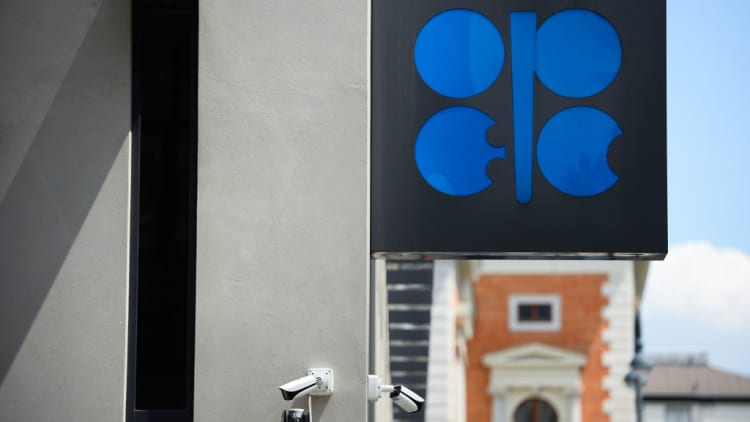It's no secret that Iran and Saudi Arabia are not the best of friends on the global geopolitical stage, but the arch-rivals have to share a space when the influential oil producing group OPEC meets Thursday.
CNBC spoke to oil market experts to get their take on how and whether Saudi Arabia and Iran manage to keep OPEC talks strictly professional when they clash so frequently in the real world and over oil.
The biggest bone of contention right now between fellow OPEC members Saudi Arabia and Iran are U.S. sanctions on the latter which have damaged its oil industry.
Understandably, Iran is not too happy with Saudi Arabia's contention that it can easily replace Iran's lost oil supply. As such, OPEC meetings can be tense affairs for Saudi and Iranian delegates.
"I have heard that there has been considerable tension in recent meetings, and that the Iranian OPEC governor has not minced words," Helima Croft, head of commodity strategy at RBC Capital, told CNBC Wednesday.
"And the sheer fact that Saudi Arabia surged production to help back out Iranian barrels means that geopolitics has played a role in production policy," she added.
Marriage of convenience?
That it would be hard for the de-facto leader of Saudi Arabia and Iran to keep OPEC talks strictly professional comes as no surprise given the long-standing hostility between them and the competing pressures their oil industries face.
Iran and Saudi Arabia are opposing religious and political powerhouses in the Middle East and relations between the Sunni-majority Saudi Arabia and Shia-dominated Iran have hit rock-bottom in recent years with civil wars in Yemen, Syria and Iraq seen as proxy wars between the two countries.
The ongoing Saudi Arabian-led economic and diplomatic blockade of Qatar, another member of OPEC (which announced its own departure from the group on Monday) also has roots in Qatar's refusal to cut ties with Iran.
Relations between Tehran and Riyadh have also not been helped by Russia's burgeoning role in OPEC's decision-making. This follows a high-profile deal in 2016 between OPEC and non-OPEC producers to cut supply in a bid to support then-slumping prices. Iran opposed the cuts, wanting to revive its oil industry that had been severely affected by previous sanctions.
Despite a persistent power struggle for most of the 20th century, however, Saudi-Iranian relations haven't always been as bad as they are now. In fact, oil was something that brought them together.
OPEC was founded by Iran and Saudi Arabia in 1960 (along with Iraq, Kuwait and Venezuela) during a period of decolonization and economic transformation in the Middle East. The oil producing group was seen as a way to challenge the dominance of western oil companies that controlled the majority of global oil supply.
Today, Iran and Saudi Arabia are two of the largest producers within the now 15-member OPEC. Saudi Arabia is the largest OPEC producer, supplying 10.6 million barrels per day (bpd) in October, according to the latest output figures supplied by OPEC, compared to the Islamic Republic's 3.3 million bpd, which makes it the third largest supplier within the group; Iraq is in second place producing around 4.6 million bpd.
Shared goals
Against this backdrop of tense relations between Saudi Arabia and Iran and their various allies and neighbors, OPEC is actually a way to keep diplomatic channels open for the two countries, according to Paul Hickin, associate director at S&P Global Platts.
"OPEC is actually a key strength for them and they can almost park their political issues and put them aside and use this as a forum to discuss things," he told CNBC Wednesday.
"But you've got to remember that they're all competitors in OPEC, they're all competing for market share and to maximize their revenues. At the same time, they also have a shared goal which is to get the best possible price for their product," he said.

Another oil market expert from S&P Global Platts told CNBC Saudi Arabia and Iran's relationship in OPEC "has traditionally been a marriage of convenience."
"Achieving sustainably higher oil prices has been their mutual goal despite deep political differences being enough to tear them apart," Andy Critchlow, S&P Global Platts' head of Energy News, EMEA, told CNBC Wednesday.
"Russia's alliance with Riyadh and President Trump's oil sanctions on Tehran have changed these dynamics. Qatar's exit from OPEC changes the game even further and exposes wider divisions, which could make cooperation on oil impossible."
Geopolitics at play
The degree of cooperation and consent within OPEC nowadays is a bone of contention for some members. Iran feels aggrieved at Saudi Arabia's alliance with the U.S. and its willingness to replace lost Iranian barrels. Iran's Oil Minister Bijan Zanganeh said in October that "Iran's oil cannot be replaced by Saudi Arabia nor any other country."
OPEC's late 2016 deal with Russia and fellow non-OPEC producers worked; perhaps too much, as it turned out. Prices rose so much that this summer both Saudi Arabia and Russia agreed to increase output in a bid to calm price rises, particularly in light of renewed U.S. sanctions on Iran from November.
But then fears of a glut set in again and oil prices began to fall and they have declined 30 percent since October. Brent crude futures are currently trading at $61.07 a barrel and U.S. West Texas Intermediate futures at $52.5 a barrel ahead of the OPEC meeting.
Amid the latest slump in prices, OPEC and Russia are looking at whether to cut supply again – the most likely scenario being a cut of between 1 million to 1.4 million bpd. This decision is one of the biggest uncertainties from the December meeting.


